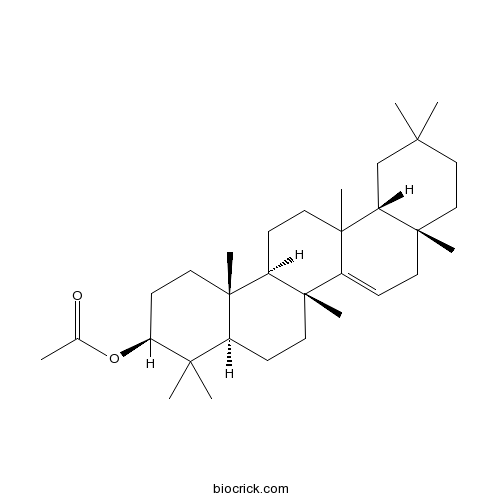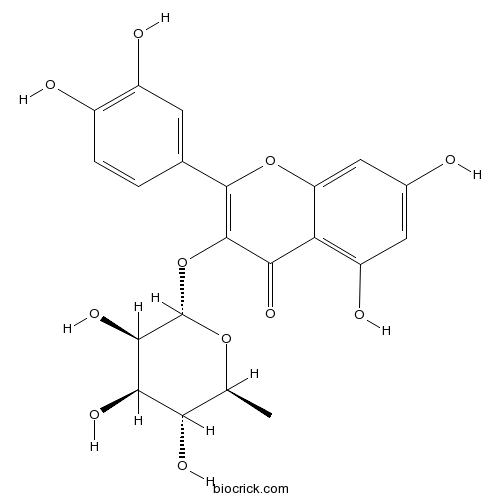Ficus pumila
Ficus pumila
1. The products in our compound library are selected from thousands of unique natural products; 2. It has the characteristics of diverse structure, diverse sources and wide coverage of activities; 3. Provide information on the activity of products from major journals, patents and research reports around the world, providing theoretical direction and research basis for further research and screening; 4. Free combination according to the type, source, target and disease of natural product; 5. The compound powder is placed in a covered tube and then discharged into a 10 x 10 cryostat; 6. Transport in ice pack or dry ice pack. Please store it at -20 °C as soon as possible after receiving the product, and use it as soon as possible after opening.
Natural products/compounds from Ficus pumila
- Cat.No. Product Name CAS Number COA
-
BCN4937
Taraxeryl acetate2189-80-2
Instructions

-
BCN5906
Chlorogenic acid327-97-9
Instructions

-
BCN5665
Quercitrin522-12-3
Instructions

-
BCN4546
4-Hydroxybenzoic acid99-96-7
Instructions

A new norisoprenoid from the leaves of Ficus pumila.[Pubmed: 29737877]
One new norisoprenoid 3,9-dihydroxy dihydro actinidiolide (1), together with eleven known compounds (2-12), were isolated from ethanol extract of the leaves of Ficus pumila collected in Hainan Province, China. Their structures were elucidated by the detailed analysis of comprehensive spectroscopic data. Compounds 1, 2, 4, 5, 8 and 10-12 were isolated from the F. pumila for the first time. All compounds were evaluated for their cytotoxic activity. Compounds 3 and 9 showed weak cytotoxic activity against Hela, MCF-7 and A549 cell lines.
A new benzofuran derivative from the leaves of Ficus pumila L.[Pubmed: 29072969]
A new benzofuran derivative, pumiloside (1), together with seven known flavonoid glycosides, afzelin (2), astragalin (3), quercitrin (4), isoquercitrin (5), kaempferol 3-O-rutinoside (6), rutin (7) and kaempferol 3-O-sophoroside (8) were isolated from the leaves of Ficus pumila. Their structures were established by spectroscopic data and comparison with the literature values.
Hypoglycemic effect and mechanism of a pectic polysaccharide with hexenuronic acid from the fruits of Ficus pumila L. in C57BL/KsJ db/db mice.[Pubmed: 29050587]
In this study, a particular pectic polysaccharide (FPLP) was extracted and purified from the fruits of Ficus pumila Linn. through boiling water extraction, alcohol precipitation, diethylaminoethyl-Sepharose Fast Flow chromatography and Superdex™ G-75 gel filtration chromatography. Analysis of high-performance gel permeation chromatography, FTIR, GC-MS, methylation and 1D/2D NMR spectroscopy revealed that FPLP (Mw: 34.69kDa) is a linear (1,4)-α-d-galacturonic acid binding 1.30% branched chain hexenuronic acid with 23.34% methyl esterification. Treatment with FPLP ameliorated hyperglycaemia in association with an improvement in hepatic glycogen metabolism in C57BL/KsJ db/db mice. The activation of IRS-1/PI3K/Akt/GSK3β/GS insulin signalling pathway and AMPK/GSK3β/GS signalling pathway and the regulation of glucokinase, phosphoenolpyruvate carboxykinase and glucose-6-phosphatase expressions involved in hepatic glycogenesis and glycogenolysis were considered the therapeutic mechanisms of FPLP. These results provide a new insight for investigating the effects of pectic polysaccharides on blood glucose control and suggest that FPLP is a promising nutraceutical for treatment of T2DM.
Contrasting genetic responses to population fragmentation in a coevolving fig and fig wasp across a mainland-island archipelago.[Pubmed: 23879300]
Interacting species of pollinator-host systems, especially the obligate ones, are sensitive to habitat fragmentation, due to the nature of mutual dependence. Comparative studies of genetic structure can provide insights into how habitat fragmentation contributes to patterns of genetic divergence among populations of the interacting species. In this study, we used microsatellites to analyse genetic variation in Chinese populations of a typical mutualistic system - Ficus pumila and its obligate pollinator Wiebesia sp. 1 - in a naturally fragmented landscape. The plants and wasps showed discordant patterns of genetic variation and geographical divergence. There was no significant positive relationship in genetic diversity between the two species. Significant isolation-by-distance (IBD) patterns occurred across the populations of F. pumila and Wiebesia sp. 1 as whole, and IBD also occurred among island populations of the wasps, but not the plants. However, there was no significant positive relationship in genetic differentiation between them. The pollinator populations had significantly lower genetic variation in small habitat patches than in larger patches, and three island pollinator populations showed evidence of a recent bottleneck event. No effects of patch size or genetic bottlenecks were evident in the plant populations. Collectively, the results indicate that, in more fragmented habitats, the pollinators, but not the plants, have experienced reduced genetic variation. The contrasting patterns have multiple potential causes, including differences in longevity and hence number of generations experiencing fragmentation; different dispersal patterns, with the host's genes dispersed as seeds as well as a result of pollen dispersal via the pollinator; asymmetrical responses to fluctuations in partner populations; and co-existence of a rare second pollinating wasp on some islands. These results indicate that strongly interdependent species may respond in markedly different ways to habitat fragmentation.
Genetic and physiological data suggest demographic and adaptive responses in complex interactions between populations of figs (Ficus pumila) and their pollinating wasps (Wiebesia pumilae).[Pubmed: 23841862]
To study interactions between host figs and their pollinating wasps and the influence of climatic change on their genetic structures, we sequenced cytoplasmic and nuclear genes and genotyped nuclear microsatellite loci from two varieties of Ficus pumila, the widespread creeping fig and endemic jelly fig, and from their pollinating wasps, Wiebesia pumilae, found in Taiwan and on nearby offshore islands. Great divergence in the mitochondrial cytochrome c oxidase subunit I (mtCOI) with no genetic admixture in nuclear markers indicated that creeping- and jelly-fig wasps are genetically distinct. Compared with creeping-fig wasps, jelly-fig wasps also showed better resistance under cold (20 °C) than warm (25 and 30 °C) conditions in a survival test, indicating their adaptation to a cold environment, which may have facilitated population expansion during the ice age as shown by a nuclear intron and 10 microsatellite loci. An excess of amino acid divergence and a pattern of too many rare mtCOI variants of jelly-fig wasps as revealed by computer simulations and neutrality tests implied the effect of positive selection, which we hypothesize was associated with the cold-adaptation process. Chloroplast DNA of the two fig plants was completely segregated, with signs of genetic admixture in nuclear markers. As creeping- and jelly-fig wasps can pollinate creeping figs, occasional gene flow between the two figs is thus possible. Therefore, it is suggested that pollinating wasps may be playing an active role in driving introgression between different types of host fig.


